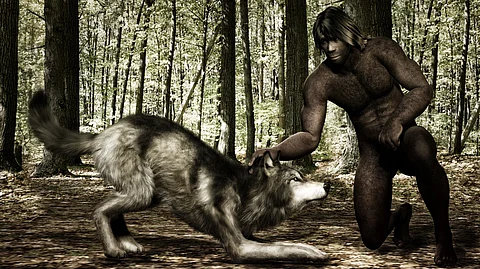

The heartwarming bond between humans and canines goes way back — much further back than previously believed. Researchers have uncovered evidence suggesting that this special friendship blossomed in the Americas a whopping 12,000 years ago. While we’ve long known that they have been our loyal companions, this new research pushes the timeline back by a significant 2,000 years.
For millennia, humans and large canids — wolves, dogs and coyotes — have shared a unique bond in northern regions like the subarctic and arctic. A study published in the journal Science Advances has shed new light on this ancient relationship, tracing its origins in Interior Alaska.
Led by François Lanoë of the University of Arizona, with contributions from University of Alaska Fairbanks (UAF) scientists, the study examined genetic, dietary and skeletal evidence from modern, ancient and fossilised canid remains from Interior Alaska archaeological sites.
The findings reveal that canids associated with human activities were far more diverse than their wild counterparts. They exhibited variations in species, genetic lineages, body shapes and diets, reflecting evolving interactions between humans and canines across time and regions.
The study deepens our understanding of early human life in the Americas, showcasing the complexity of human-canid relationships. From hunting partners to scavengers and cherished companions, these interactions began far earlier than previously thought.
One striking discovery involved the diets of ancient canids. Researchers conducted chemical tests on a 8,100-year-old canine jawbone and a 12,000-year-old canine legbone discovered in interior Alaska. This helped them reconstruct what ancient and modern wolves ate, comparing their diets to canine remains found at archaeological sites.
Wolves, both ancient and modern, showed minimal salmon consumption — a stark contrast to the diets of canines associated with human camps, according to UAF anthropology professor Josh Reuther.
“The remains from the archaeological sites had a much larger concentration of salmon,” Reuther said in a statement, suggesting that humans were actively sharing their catch with the canids.
Ben Potter, a UAF archaeologist and co-author of the study, called the presence of salmon protein “the smoking gun.” Wolves in the wild rarely consume salmon, meaning these canines were likely receiving food from humans.
While the findings point to close relationships between humans and canines, the researchers are cautious about calling these early companions “domesticated dogs.” Genetically, the ancient canids studied are not related to modern dogs. Instead, they may have been tamed wolves, Lanoë explained.
“Behaviourally, they seem to be like dogs, as they ate salmon provided by people,” he said. But whether they were fully domesticated remains uncertain. This raises what Potter calls an existential question: What is a dog?
The study also highlighted the enduring bond between canines and humans, particularly within Alaska’s Indigenous communities. For decades, archaeologists have collaborated with tribal councils in the Tanana Valley, including the Healy Lake Village Council, which authorised genetic testing for the study.
Evelynn Combs, an archaeologist and member of the Healy Lake tribe, emphasised the spiritual and cultural significance of dogs in a University of Arizona news release, saying dogs have always been mystic companions to our people. Her own connection with a Labrador retriever mix named Rosebud underscores the timelessness of this bond.
“I really love that we can look at the record and see that thousands of years ago, we still had our companions,” she stated.